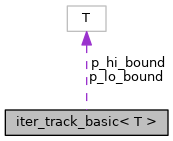template<class T>
class iter_track_basic< T >
iter_track_basic is a lightweight version of iter_track designed to keep the state information to an absolute minimum (2 FP numbers). This is also why it is implemented as a template so that you can choose a single- or a double- precision version according to your needs.
when you are trying to iteratively converge a quantity using an algorithm some_func(), iter_track_basic will help you by establishing a bracket and performing a bisection search once the bracket is found. The reason for using this algorithm is that it can speed up convergence. Once the bracket is established, the width of the bracket is guaranteed to halve every iteration. Use it by replacing the following (oversimplified) code
realnum old, new; while( abs(old-new) > tol ) { old = new; new = some_func(old); }
with
iter_track_basic<realnum> tr; realnum old, new; while( abs(old-new) > tol ) { old = new; new = tr.next_val( old, some_func(old) ); }
the algorithm assumes that some_func() is well-behaved in the sense that when old < some_func(old) then also old < final, and when old > some_func(old) then also old > final, where "final" is the true converged value. These assumptions are used to establish a bracket. If these assumptions are violated, it may be impossible to converge onto the correct value!

